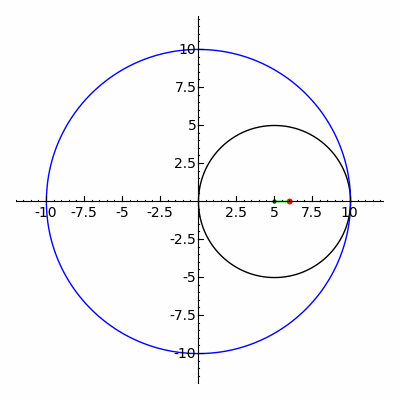Hypotrochoid with a deeply caring vengence for recycling
Let the Lune be De fined
By Arc AEB~f
De fined by the Circle
Centered at Point D
And A Chord of
Circle ABC De Fined
By Center point O
The Area of the Lune is
Found outside
Circle ABC
AND
equal to
The Area of Isocoles Triangle
ABO
Found Inside Circle ABC
Proof
[edit]Hippocrates' result can be written as follows:
The point D is
The center of The Circle on Which
The arc AEB lies,
The point D is
the midpoint of the hypotenuse of
the isosceles right triangle ABO.
The length of Line AB is
Given by the only formula in Mathematics
[AB squared] [is equal to] [AO squared added to OB Squared]
And
For an Isosceles Triangle Δεφινεδ
ασ a Tri angled pHorm pHormed pHrom two sides
Joined by
One Right Angle
Therefore
The diameter AC
of the larger circle ABC is
times the diameter of the smaller circle
Which is
Making AC equal to Χ
or TWO
Where the arc AEB is found
Therefore,
the smaller circle has
half the area of the larger circle,
Therefore
the quarter circle AFBOA
is equal in area to the semicircle AEBDA.
The crescent-shaped area AFBDA
IS part of Both PArts
and so when Added to
the quarter circle gives triangle ABO
and Adding the same crescent
to the semicircle gives the lune.
Since the triangle and lune are
both formed by
Adding
an equal area
from equal areas,
To Equal areas
the Sum of the areas themselves
In chemistry, a zwitterion (/ˈtsvɪtəˌraɪən/ TSVIT-ə-ry-ən;
from German Zwitter [ˈtsvɪtɐ] 'hermaphrodite'),
also called an inner salt or dipolar ion,[1]
is a molecule that contains an equal number of positively and negatively charged functional groups.[2]
1,2-dipolar compounds, such as ylides, are sometimes excluded from the definition.[3]
Applying Ampère's circuital law to the solenoid (see figure on the left) gives us
where is the magnetic flux density, is the length of the solenoid, is the magnetic constant, the number of turns, and the current. From this we get
This equation is valid for a solenoid in free space, which means the permeability of the magnetic path is the same as permeability of free space, μ0.
If the solenoid is immersed in a material with relative permeability μr, then the field is increased by that amount:
The vacuum magnetic permeability (variously vacuum permeability, permeability of free space, permeability of vacuum, magnetic constant) is the magnetic permeability in a classical vacuum. It is a physical constant, conventionally written as μ0 (pronounced "mu nought" or "mu zero"). It quantifies the strength of the magnetic field induced by an electric current. Expressed in terms of SI base units, it has the unit kg⋅m⋅s−2⋅A−2. It can be also expressed in terms of SI derived units, N⋅A−2.
Since the revision of the SI in 2019 (when the values of e and h were fixed as defined quantities), μ0 is an experimentally determined constant, its value being proportional to the dimensionless fine-structure constant, which is known to a relative uncertainty of 1.6×10−10,[1][2][3][4] with no other dependencies with experimental uncertainty. Its value in SI units as recommended by CODATA is:
The terminology of permeability and susceptibility was introduced by William Thomson, 1st Baron Kelvin in 1872.[6] The modern notation of permeability as μ and permittivity as ε has been in use since the 1950s.
The Breadth ορΗ βγεαΔ Θ
As the Motion of
Ba~re~a~th
.png)
























Comments
Post a Comment
No Comment